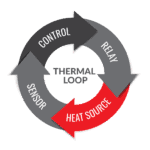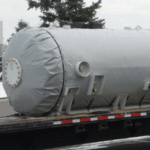*Note – This is the second article in our series on the thermal loop. See the bottom of this article for all posts in this series.
Temperature controllers are designed to perform the function of keeping an object or process at a desired temperature. In every application where controlling a temperature is required, a controller is used to set a temperature by way of a set point. A sensor of some kind is used to compare the temperature at that location to the set point required.
Some applications require heat to maintain a specific temperature, while some require cooling, and others require both. Maintaining temperature is critical in many applications.
There are three main types of temperature controllers: On/Off, Proportional and PID Controllers.
What is an On/Off Controller?
On/Off Controllers are most commonly represented by thermostats. Temperature sensor types can vary, but most often a mercury-filled bulb and capillary system is used. Other sensors like thermistors, thermocouples or RTD’s can also be used as sensors for On/Off Controllers.
How does an On/Off controller work?
The name On/Off comes from the method of sending the signal to cool or heat: the system is on or off. It’s pretty simple. These systems work well and have been used for over 100 years. Temperature swings are bigger, and these on/off systems are not recommended for systems needing precise temperature control. Swings of 2-5% or greater can be had above and below the temperature set point.
What is a Proportional Controller?
Proportional controllers are a bit different. These units most often use thermocouples or RTD’s for temperature-sensing input.
How does a proportional controller work?
Here’s how a proportional controller works: A temperature set point is dialed in and set. As the temperature comes close to the set point, the controller turns the heating or cooling load on or off once it hits a deadband that is normally 5-10% before or after the set point. For example, if the set point to heat was 100 F, and the controller had a 10% deadband, there would be a range of 10% around the set point. 10% of 100 is 10 F, and most proportional controllers will “split” the deadband around the set point: 5 degrees above, and 5 degrees below. Once the sensed temperature reaches 95 F, the controller will actually proportion the signal until it hits 100 F. The sensed temperature will overshoot the set point a little, but when it reaches 105 F, the controller will begin to proportion the signal on again until it hits 100, then it is full on again.
Proportional controllers do a better job controlling the temperature around the setpoint than On/Off controllers and provide for a more stable range of temperature.
What is a PID Temperature Controller?
PID controllers are really the “best” in the good, better, best comparison. They are designed to provide more accurate and efficient control. These controllers are designed to look at multiple performance factors of your heating systems to provide accurate and efficient temperature control.
What does PID stand for?
PID stands for three main feedback functions called proportional, integral and derivative. Each has its own specific function in a system that uses PID control.
-Proportional stands for the controllers ability to see the set point coming up, and calls for the heater or temperature control device to slow down. This is normally at a specific temperature on a temperature control system (for example, 5 degrees below the set point).
-Integral is an employed algorithm that looks at how the system settles out below that setpoint. Once the “P” is initiated, it may not provide that little bump needed to get the temp up to its setpoint.
-Derivative works it from the other side of the system. If the temperature consistently settles above the set point, the derivative will work to reduce control output so that the set point comes down.
How does a PID Controller work?
Together, PID functions work in harmony to have a very tightly monitored temperature control system. Most PID temperature controllers have a process called “Autotune” that allows a PID controller to “learn” it’s specific system. An individual using the autotune process would typically energize their system with the controller’s PID settings set to factory default. They would then initiate the autotune process and see in the heating process a drop of 50 F or so from the input set point (for example, if your temperature controller set point is 200 F, it would drop the temperature to 150 F. Then the system would apply heat to get back up to the original set point of 200 F.) It may do this 2-3 times before it learns what P, I, and D settings to apply.
The controller will take note of how fast the system loses heat, how fast it heats up and then adjusts the P, I and D settings accordingly. This is very helpful in creating a PID controller that is accurate and useful. The controller actually “learns” your process and applies what it deems are the best settings. This translates into a more efficient system.
What is the best temperature controller?
Every temperature sensing application is different. For systems that are in charge of heating a large, open or large mass product that just cannot change temperature very quickly, an On/Off controller is great.
An everyday example of this is most home heating and air conditioning systems, which are commonly On/Off control. You might see 72 F on your thermostat, but that is just the setpoint. The real temperature is always above or below that.
A large tank is another great example of a process that would be fine for an On/Off Controller. When heating or cooling is applied to the large tank or its contents, the product within it cannot change temperature very quickly.
Finally, heat trace is another great use of an On/Off Controller. No matter how much power is applied, the surface of whatever the heat trace is attached to will not change temperature very fast.
Proportional control is great for processes that need a fairly good control of temperature within a difference of 2-3 degrees. A smaller tank or heat trace application that could be easily affected by the application of heat or chill would be a great candidate for proportional control. It would be a little tighter of a control system with less waste heat, which is better than On/Off but not as tight as PID.
Finally, PID control for temperature control systems are used for highly precise applications. Gasses and other critical products can often not tolerate large temperature swings. Many heating or cooling applications require a product to get to and stay at a temperature for a specific period of time. Curing composites or gas regeneration of catalysts are a couple of examples. To ensure there are no swings in temperature during the heating process, a PID temperature controller with a properly placed sensor and a correctly sized heating or cooling system can work much better than other methods of controlling temperature.
Call our Team here at Powerblanket today and let’s get the right controller for you.
The Thermal Loop
4- On/Off Controls and the Thermal Loop
5- Proportional Control in the Thermal Loop
6- Temperature Sensors and Perfect Placement
Powerblanket's industrial control solutions give you the power to automate, remotely control, and monitor your valuable materials and equipment.




